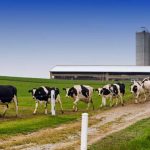
Globally, almost 970 million tons of milk was produced in 2022, 55% of it processed for further dairy commodity production. The other 45% is “informal market,” which means consumed by households or sold to traders. During the past 10 years, milk production has grown 2% annually, Yunusov said.
Milk consumption is also on the rise. The average person consumes 123 kilograms of milk per year. In richer economies, the average is 300 kilograms, he said.
From the economics of dairy farming to the labeling dilemma of alternatives to cow milk, here are six trends dairy producers should keep an eye on right now:
1. The impact of macroeconomic developments on the industry
In the aftermath of the COVID-19 pandemic, countries with slowed GDP growth experienced high inflation rates, leading to a decline in global purchasing power that also affected the dairy sector.
These fluctuating macroeconomic trends have had implications for farmgate milk prices, which are weighted averages of cheese and butter, skim milk powder, whole milk powder, and whey. A price increase of 30% to 60% was observed during 2021 and 2022, creating a mixed outlook for the industry.
Additionally, the Russian invasion of Ukraine emphasized the necessity for strategic adjustments in macroeconomic policies, especially in a globally integrated industry like dairy.
2. The influence of inflation on milk pricing
From 2017 to 2020, the average farmgate milk price stood at around US$40 for 100 kg of milk. However, as demand surged in 2020, the milk price underwent a significant surge as well, reaching an all-time high in mid-2022. Consumers found it challenging to sustain their purchasing power, and this ultimately led to a decline in milk prices.
“If you are trading a lot in the global market, it means that your national farmgate milk prices are also declining quicker if you are not in this global trade,” Yunusov commented on the role of global trade in shaping national farmgate milk prices. “You may have this downgrading effect after eight to nine months.”
These intricate dynamics highlight the complex relationship between inflation, demand and affordability, all of which hold substantial implications for the dairy industry and its stakeholders.
3. High input costs and their effect on investments
Yunusov highlighted the shock situation triggered by factors such as increased energy and fertilizer costs, along with supply chain disruptions, which have led to higher farm input expenses. This escalation in costs, coupled with a temporary reduction in milk production in several net exporting countries, has imposed significant pressure on farmers.
It is important to reassess margin calculations, considering not only feed costs but also energy and fertilizer expenses. Results of such assessments have revealed that farmers’ margins have been strained due to these elevated input costs. While many farms were able to generate satisfactory profits through efficiency and good management, smaller-scale farms with lower efficiency faced the risk of profit losses.
4. Food insecurity and unmet demand
According to Yunusov:
- One billion people are living in net exporting countries of dairy.
- Three billion people are living in net importing areas of dairy.
- Four billion people cannot afford to buy dairy.
For example, in Western Europe, people consume one liter of milk per day on average, whereas in China that number is less than one glass of milk per day.
When considering the future of net exporting countries, we must consider the unintended consequences faced by those unable to afford dairy products. Addressing the decline in affordability, and effectively tackling food insecurity, are emerging as critical tasks within the dairy industry.
IFCN predicts that by 2030, over 14% more milk will be produced and consumed, Yunusov said — reaching about 1.1 billion tons. Milk production will grow mainly outside the current top exporting countries, he said, and unsatisfied demand is expected to increase.
5. Enhancing efficiency through strategic actions
A key efficiency indicator highlighted by Yunusov was milk yield per cow, and he emphasized the need to adapt farming systems to suit the specific requirements of different countries and regions.
In low-income countries with small-scale farming operations and a limited number of cows, improving efficiency in feeding becomes crucial not only for providing nutrition to families but also for generating an income source.
Conversely, high-income countries with larger economies of scale need larger herd sizes and advanced farming systems to optimize efficiency.
“Optimization and robotization are extremely important, because at the end, once you have this high-income situation in the neighborhood, you definitely automatically will have an issue of this labor shortage,” Yunusov said.
6. Labeling dilemma: Nut- and plant-based milks in the dairy industry
Yunusov contended that non-dairy liquids, like soy milk, should not be bestowed with the term “milk,” as they do not originate from mammals. Notably, legislation in Europe has already implemented restrictions on the usage of terms such as “soya milk,” mandating designations such as “soya drink” instead.
Yunusov noted the significance of offering consumers, particularly the younger generation, an accurate perspective by educating them about the nutritional merits of dairy products.
“Dairy alternatives are there, but we should not forget that the dairy business has a tremendous opportunity to grow,” he said. “It’s important to review all of your strategies until 2030, because we are in a fast-changing world. You need to learn fast; you need to adapt fast.”
Related ONE content
Alltech ONE Budapest explored the strategies for remaining resilient amid the significant challenges facing our industry. It offered captivating insights from industry experts on topics of production efficiency, risk management, the power of data, and partnerships — all through the lens of sustainability.
























